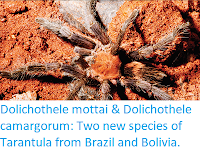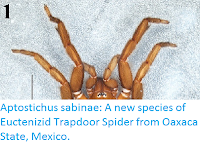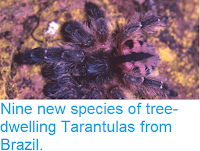Trapdoor Spiders are Mygalomorph Spiders (Spiders
that lack opposable fangs, the same group as the Tarantulas) noted for
the habit of excavating a burrow which they cover with a circular
trapdoor, emerging from this to seize prey. They were formerly assumed
to be a single taxonomic group, but the advent of molecular phylogenetic
methods has revealed that several different Mygalomorph groups have
independently evolved this lifestyle. The Nemesiidae are a large group of Trapdoor Spiders sometimes known as Funnel-web Tarantulas. The are found on every continent, though they are more common on the continents of the Southern Hemisphere, and have a fossil record that dates back to the Cretaceous.
In a paper published in the journal ZooKeys on 3 June 2019, Jason Bond of the Department of Entomology & Nematology at the University of California Davis, and Trip Lamb of the Department of Biology at East Carolina University describe a new species of Funnel-web Tarantula from Namibia.
The new species is placed in the genus Pionothele, which has previously only been recorded in South Africa, and given the specific name gobabeb, in reference to the area where it was found, close to the Gobabeb Research & Training Center, about 120 km southeast of the Atlantic coastal city of Walvis Bay, where the ephemeral drainage of the Kuiseb River meets the northern terminus of the Namib Sand Sea and the gravel plains of the Central Namib. The species is described from fifteen male specimens collected from pit traps after a rain event (this is fairly typical for Trapdoor Spiders, with the males roaming in search of females, either at certain times of year or after certain weather events), plus one female collected from a burrow on a sandy slope.
The males range from 6.18 to 7.59 cm in length and from 5.72 to 6.8 cm in width, the female is 8.13 cm long and 6.08 cm wide, and notably more robust. Both sexes are pale brown in colour with fine white hairs on the body and darker hairs on the limbs. The posterior lateral eyes are much reduced in size compared to the median eyes, something not seen in the other two species in the genus.
See also...
In a paper published in the journal ZooKeys on 3 June 2019, Jason Bond of the Department of Entomology & Nematology at the University of California Davis, and Trip Lamb of the Department of Biology at East Carolina University describe a new species of Funnel-web Tarantula from Namibia.
The new species is placed in the genus Pionothele, which has previously only been recorded in South Africa, and given the specific name gobabeb, in reference to the area where it was found, close to the Gobabeb Research & Training Center, about 120 km southeast of the Atlantic coastal city of Walvis Bay, where the ephemeral drainage of the Kuiseb River meets the northern terminus of the Namib Sand Sea and the gravel plains of the Central Namib. The species is described from fifteen male specimens collected from pit traps after a rain event (this is fairly typical for Trapdoor Spiders, with the males roaming in search of females, either at certain times of year or after certain weather events), plus one female collected from a burrow on a sandy slope.
Aerial photograph of type locality. Kuiseb River bed in foreground (tree line); the interdune pitfall trap transect lies beyond the dunes (middle right of image). Bond & Lamb (2019).
The males range from 6.18 to 7.59 cm in length and from 5.72 to 6.8 cm in width, the female is 8.13 cm long and 6.08 cm wide, and notably more robust. Both sexes are pale brown in colour with fine white hairs on the body and darker hairs on the limbs. The posterior lateral eyes are much reduced in size compared to the median eyes, something not seen in the other two species in the genus.
Pionothele gobabeb, specimens in dorsal view, (3) male, and (4) female. Bond & Lamb (2019).
See also...
Follow Sciency Thoughts on Facebook.








